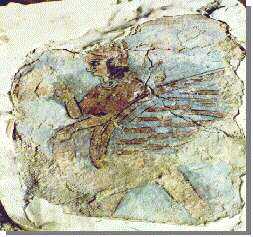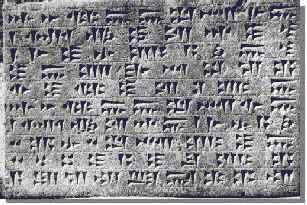|
| "In
the Metsamor kingdom, early script forms go back to around
2000 BC " |
When Sumeria perfected the wedge-shaped cuneiform around 3000
BC, it introduced an alphabet to the world, and the relatively
quick and easy method of describing things (and oh how the Sumerians
loved to describe things 80% of their clay tablets are lists
of things) caught on with other countries.
While it influenced
other attempts at writing, it did not usurp them. In the Metsamor
kingdom, early script forms go back to around 2000 BC. The
script uncovered in this period has moved away from simple iconography
to symbols with complex meanings, and they appear in lines or
groups the first sentences created by ancestral Armenians. The
symbols are very far removed from Sumerian wedge shaped slashes
on clay they function as a communication device while at the
same time they are elegant pictures of divine presence on earth.
Accomplished astronomers
a thousand years before the Sumerian Script, ancestral Armenians
were steeped in a religious iconography revolving around the
sun, the moon, the planets and the stars. A pantheon of gods
inhabiting the constellations of the zodiac which experts believe
had been completed ca. 2800 BC was "captured" in sacred script
found at places of worship. By around 2000 BC, the "Metsamor
Script" had been codified and was widely used in ancestral Armenian
lands. Not so curiously, this script is found outside urban
areas, and appears in remote areas of the country places where
it is easy on a clear night to gaze at the stars and identify
the home of the gods, to catch their moods and predict future
events.
 As
a script reserved for religious purposes, writing and divining
symbolic meanings were reserved for the priest classes and here
is something scholars neglect to inform readers in their thesis’.
The fact you can read this article at all is a miracle of the
modern age. The vast majority of the population back then could
never have deciphered their script, even if they had been allowed
to read. They were illiterate. As
a script reserved for religious purposes, writing and divining
symbolic meanings were reserved for the priest classes and here
is something scholars neglect to inform readers in their thesis’.
The fact you can read this article at all is a miracle of the
modern age. The vast majority of the population back then could
never have deciphered their script, even if they had been allowed
to read. They were illiterate.
Regardless of the
intricacy, beauty or functionality of any old script from the
majestic Egyptian Hieroglyphs to the compact Sumerian cuneiform,
or the elaborate Chinese pictograms writing was reserved for
the upper classes it was a weapon as strong as any sword in
keeping the peasants passive. Literacy is a recent event in
the concept of time it isn’t widespread in the "civilized" countries
until the end of the 19th century, and is only now
making inroads worldwide.
To a great extent,
the picture quality of old scripts was kept even as a culture
moved to more efficient ways of writing, simply to give the
peasant class some clue as to what the authors were up to. While
they could never have understood the intricacies of pluperfect
or passive tenses, let alone the grave error of a dangling participle,
they could spot a spiraling sun disc placed over the
head of the king. They lived in pictures, studied them for spiritual
meanings, and were comforted or terrorized by the interpretations
made by the priests.
Writing was kept
by the religious class, and passed on to only a select few.
Sometimes the aristocracy could read, but there were more than
a few kings who didn’t have a clue what their own priests were
writing. I like to imagine the development of reading had a
lot to do with keeping tabs on what the scribes and priests
were up to, as much as it did with impressing the locals with
erudite learning. By the time Urartu rose, second sons were
routinely assigned positions of High Priest, keeping the family
business of running an empire close at home. Wouldn’t want anyone
changing the archives just when we are about to enter eternal
god-status, now would we?
By the time Urartu
rose in prominence in the region, they had developed a dual
system of writing. Visitors to Urartian excavations like Erebuni
learn that Urartu used cuneiform, and that it was borrowed from
Assyrian script.
 For
a while this caused classical scholars to surmise that Urartu
was little more than a regional power that absorbed a more refined
Assyrian culture as they rose to power. And it seems to fit:
A mountainous tribe captures most of Anatolia and then looks
up from the dust to find a glorious culture to the South. To
read some scholars, the ensuing wholesale "invasion" of Assyrian
architecture, design and religious iconography reads like a
country cousin rampaging through Rodeo Drive on credit. ("Like
that Babylonian bull effigy, Marj? We’ll take fifteen hundred
for the temple. Oh, and throw in a few hundred lapis lazuli
snake charms for the mid-winter banquet."). Oh, those classical
scholars. For
a while this caused classical scholars to surmise that Urartu
was little more than a regional power that absorbed a more refined
Assyrian culture as they rose to power. And it seems to fit:
A mountainous tribe captures most of Anatolia and then looks
up from the dust to find a glorious culture to the South. To
read some scholars, the ensuing wholesale "invasion" of Assyrian
architecture, design and religious iconography reads like a
country cousin rampaging through Rodeo Drive on credit. ("Like
that Babylonian bull effigy, Marj? We’ll take fifteen hundred
for the temple. Oh, and throw in a few hundred lapis lazuli
snake charms for the mid-winter banquet."). Oh, those classical
scholars.
Thankfully, new
information has come to light showing there was as much influence
on Assyria by the Urartians as vice versa. While the Assyrians
seem to have taken Sumerian and Babylonian worship of animal-gods
and sent them north to Urartu, the entire Assyrian astronomical
tradition can be traced to the much earlier Metsamor period.
Almost identical designs used in Assyrian frescoes and carvings
have their earliest representations in the Armenian plateau.
As for script, the
Urartians placed cuneiform in public places, designed to assert
authority over anyone who could read it which would have been
one of several thousand Assyrian prisoners taken in battle.
The educated prisoners understood the meaning of the use of
"their" script: A power had risen in the North to rival their
own, great enough to absorb the culture of the South. Most depressing
of all, it was great enough to change it to a more refined style.
Frescoes uncovered in Assyrian palaces and throne rooms from
the period show whole scale adoption of Urartian symbols and
designs.
 For the other, illiterate prisoners, it was a blow against myths
that Urartu was nothing more than a bunch of mountain tribes.
Not only did they copy the sacred Assyrian script, they flung
it in the face of their enemies.
For the other, illiterate prisoners, it was a blow against myths
that Urartu was nothing more than a bunch of mountain tribes.
Not only did they copy the sacred Assyrian script, they flung
it in the face of their enemies. 
And Urartians used
a second script along with cuneiform. This script seems to be
reserved for more prosaic uses, though symbols appear along
with cuneiform in temple and palace areas. The Urartian script
is a much-developed version of the Metsamor Script, though it
still relies on pictures to communicate ideas. Rival Haikasian
script had begun the conversion of pictures into more abstract
symbols. Whether either were used like alphabets to capture
sounds that are strung together to make words no one who wasn’t
around at that time really knows.
During the Urartian
period (ca. 1200-650 BC), other scripts were used in ancestral
Armenia, among them the Armavir (1100 BC) and the Cholagerd
(850-750 BC) scripts.

Neither script has
been found to include more than a few symbols, and none have
been deciphered adequately to tell whether they were actual
words, pictures of events, or geographical map symbols. They
seem at first glance to be holdovers of the earliest pictogram
tradition in the area, and since they were used by remote tribes,
they might represent a sort of local dialect.
|